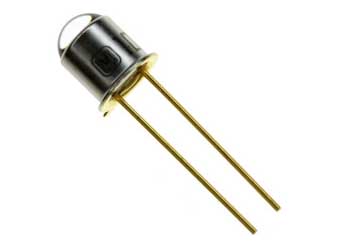Phototransistor Supplier
What is a phototransistor?A phototransistor is a transistor with three electrodes, of which the base is not drawn out. When the intensity of light changes, the resistance between the electrodes will change accordingly. The phototransistor can control the size of the collector current according to th
What is a phototransistor?
A phototransistor is a transistor with three electrodes, of which the base is not drawn out. When the intensity of light changes, the resistance between the electrodes will change accordingly. The phototransistor can control the size of the collector current according to the intensity of light, so that the phototransistor is in different working states. The phototransistor only leads out the collector and the emitter, and the base serves as the light receiving window.
Brief introduction of phototransistor
Phototransistor, also known as phototransistor, is a semiconductor optoelectronic device whose current is controlled by external light. A phototransistor is a triode that is equivalent to connecting a photodiode between the base and collector of the triode, and the current of the photodiode is equivalent to the base current of the triode. Because of its current amplification effect, the phototransistor is much more sensitive than the photodiode, and can output a large photocurrent at the collector.
Phototransistors have various packaging structures such as plastic packaging, metal packaging (the top is a glass mirror window), ceramics, and resin. The pins are divided into two-pin and three-pin types. Generally, for a phototransistor with two pins, the pins are the collector and the emitter, and the light window is the base.
When there is no light irradiation, the phototransistor is in a cut-off state, and there is no electrical signal output. When a light signal illuminates the base of the phototransistor, the phototransistor turns on. First, the photoelectric conversion is realized through the photodiode, and then the photocurrent is amplified through the triode, and the amplified electrical signal is output from the emitter or collector.
 |  |  |
| photosensitive sensor Appearance: Ø5 Product features: low power consumption, high reliability, high consistency Photocurrent: VDD=5V, EV=10Lux 1.5-5uA Peak photosensitive wavelength: 520nm Sensitive wavelength range: 450-700nm Power Consumption: 70mW Recommended matching: high stability resistor Overview of photosensitive sensors 1. Instead of traditional photoresistor (CdS), it does not contain harmful substances such as cadmium and lead, and complies with EU ROHS standards 2. Automatically adjust the background light, such as LCD, mobile phone, camera, computer camera, etc. 3. Suitable for all kinds of light-controlled lighting products and light-controlled toys: such as night lights, etc. 4. Applicable to various infrared monitoring products Features of photosensitive sensors ★ Peak photosensitive wavelength 520nm ★ Low power consumption ★ High reliability ★ Good batch consistency, completely solve the phenomenon of premature lamp start or poor consistency ★ Fast response, stable performance, aging 1000H starting point does not drift under +85℃ high temperature/65% high humidity conditions ★ Different dimensions can be provided upon request, easy to install in any position of the product | LS06-J photosensitive sensor Appearance: Ø5 Product features: low power consumption, high reliability, high consistency Photocurrent: VDD=5V, EV=10Lux 400-450uA Peak photosensitive wavelength: 850nm Sensitive wavelength range: 450-1050nm Power Consumption: 70mW Recommended matching: high stability resistor Overview of phototransistors 1. Instead of traditional photoresistor (CdS), it does not contain harmful substances such as cadmium and lead, and complies with EU ROHS standards 2. Automatically adjust the background light, such as LCD, mobile phone, camera, computer camera, etc. 3. Applicable to various light-controlled lighting products and light-controlled toys: such as night lights, etc. 4. Applicable to all kinds of light-controlled infrared detection and testing equipment, etc. Characteristics of phototransistors ★ Peak photosensitive wavelength 850nm ★ Low power consumption ★ High reliability ★ Good batch consistency, completely solve the phenomenon of premature lamp start or poor consistency ★ Fast response, stable performance, aging 1000H starting point does not drift under +85℃ high temperature/65% high humidity conditions ★ Different dimensions can be provided upon request, easy to install in any position of the product | Ø3 photoresistor Appearance: Ø3 Product features: low power consumption, high reliability, high consistency Photocurrent: VDD=5V, EV=10Lux 50-120uA Peak photosensitive wavelength: 850nm Sensitive wavelength range: 450-1050nm Power Consumption: 70mW Recommended matching: high stability resistor Overview of Ø3 photoresistors: 1. Instead of traditional photoresistors (CDS), it does not contain harmful substances such as cadmium and lead, and complies with EU ROHS standards 2. Automatically adjust the background light, such as LCD, mobile phone, camera, computer camera, etc. 3. Suitable for all kinds of light-controlled lighting products and light-controlled toys: such as night lights, etc. 4. Applicable to all kinds of light-controlled infrared detection and testing equipment, etc. Characteristics of Ø3 photoresistors: ★ Peak photosensitive wavelength 850nm ★ Low power consumption ★ High reliability ★ Good batch consistency, completely solve the phenomenon of premature lamp start or poor consistency ★ Fast response, stable performance, aging 1000H starting point does not drift under +85℃ high temperature/65% high humidity conditions ★ Different dimensions can be provided upon request, easy to install in any position of the product |
The working principle of phototransistor
The basic structure of a phototransistor is the same as that of an ordinary triode, with two PN junctions. Figure 1 is the NPN type, the b-c junction is the light receiving junction, which absorbs the incident light, the area of the base area is large, and the area of the emission area is small. When light is incident on the surface of the base, photogenerated electron-hole pairs are generated, and under the action of the b-c junction electric field, the electrons drift to the collector. The holes move to the base, causing the base potential to rise, and under the action of the applied voltage between c and e (c is +, e is -), a large number of electrons are injected from the emitter. Except for a small number of holes recombined at the base, a large number are collected by the collector through the extremely thin base and become output photocurrent.

